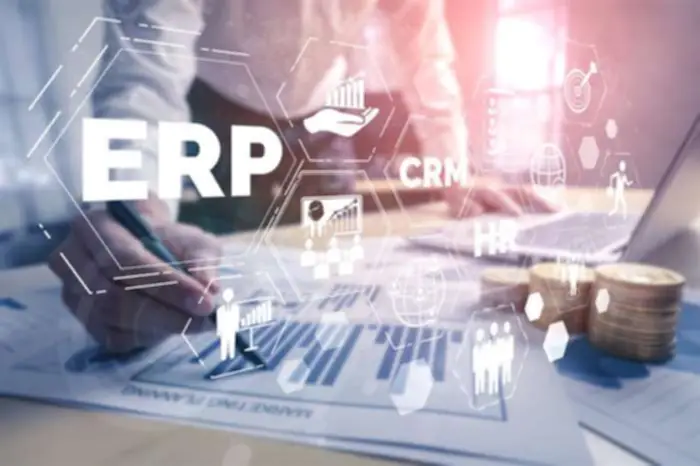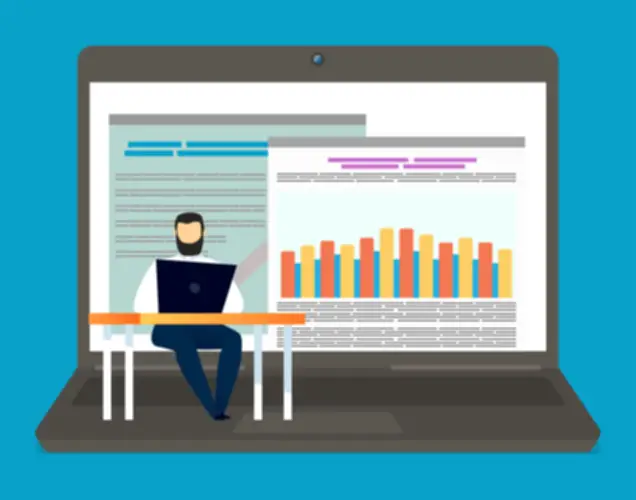ERP Development: Create and develop your own system

Managing business processes is always a difficult task. However, ERP comes as a perfect solution. Everything that is related to your company is available within one application.

Find out how to develop yours now!
What is ERP?
ERP, or also known as Enterprise Resource Planning, is software that assists in the management of various business processes in one place. The application can cover different fields, like accounting or logistics. It all depends on the needs of your company.
An ERP is mostly needed for large companies to properly manage their business processes. Here are some statistics to show the significance of this software:
- Over 49% of businesses that have implemented an ERP improved their business processes;
- In 2018, the ERP market size was $14,7 billion and is expected to reach $50 billion by 2024;
- North America occupies the biggest part of the ERP market, which is already over $10 billion.
The best thing about this software is that companies stop wasting their resources. Many ERP system examples can be found on the internet.

We are confident that we have what it takes to help you get your platform from the idea throughout design and development phases, all the way to successful deployment in a production environment!
Custom-made ERP: Pros and cons
Technically, a custom-made ERP means doing it the hard way because this is where you need to create and develop a unique system that is specifically designed for your business. There is no need to rebuild the software you get from the vendors, but everything must be built from scratch.
Advantages
- Complete customization
- Add whatever features you need
- The build depends only on you.
Disadvantages
- Enormous development costs and no precise price until the process begins
- A varied development time for each project, but generally long.
Out-of-the-box ERP: Pros and cons
This is the easy way. Here, you get a ready system from a vendor and simply tweak it in accordance with your needs.
Advantages
- Good choice for low budgets
- Quick deployment.
Disadvantages
- Functionality gaps
- Regular fees
- Many unnecessary functions.
How to build a custom ERP in 5 steps
Now, we shall cover the 5 steps of building a unique ERP for your business. Try following each of them when you start creating a product of your own.
1. Set the goal and requirements
If you want a product that would solve the issues of your business, it is crucial that you know your company’s needs. Otherwise, creating the needed software would be nearly impossible.
What should the ERP do? How can it help?
In most cases, businesses use ERPs for the following processes:
- Sales
- Funding
- Recruitment
- Product distribution, delivery, development.
Think of all the processes in your company and create a list of everything that must be included.
2. Think of the design
While you might think that design is an insignificant part of your project, most cases show that this, in fact, is one of the most important details in ERPs. The key elements of a good system are a user-friendly interface, intuitive design, and understandable feature placement.
Try building a dummy-model to see how the final result would look like. It is best if you stick to simplicity and do not reinvent the wheel.
3. Select a robust tech stack
Stable software requires a robust tech stack.
Speaking of desktop platforms, you will, most likely, use C++ for Windows and Swift for macOS. For web versions, developers usually work with Angular or JavaScript.
There is a huge number of technologies that are required for each part of the project. Front-end, back-end, database, integrations — there is something for each.
4. Module integration
Adding software like Office 365 or other similar apps to your ERP is possible with proper third-party integration. The data is accessed and shown in different ways. It is all determined by the solution chosen by the engineer.
5. Check the final product
The final stage involves a lot of testing. Each addition must be checked in order to avoid unwanted bugs and errors. To avoid these, the easiest option is performing regular tests at each development stage. A new feature was added? Check whether it works properly!
Apart from making the developers and special testers try out the software, let your employees try to work with it. They might find something that the developers wouldn’t even think of.

ERP development costs
Calculating the final price is always difficult because you never know how much time it could take. In most cases, the costs start at $25,000 and go up to $350,000. The pricing is determined by the requirements, features, platforms, and a lot of other details.
Having an in-house team of developers can help you get a proper estimate. They are aware of your business processes and understand the needs, so that would simplify the calculation.
You might be shocked by the costs. Why would an ERP cost that much?
- Complexity;
- Who develops the project;
- Where the project is developed;
- Are the developers juniors, middles, or seniors?
Consider these facts when the costs surprise you again. If you have a shoestring budget, try to remove an element that is least prioritized.
The bottom line
Now that you know what is ERP software and how it is developed, it is time to create something for your own business. The easiest way to do this is by contacting the GlobalCloudTeam for help. Reasonable pricing for high-quality results!
Top Articles
Container vs VM (Virtual Machines): How Do They Differ?
I am here to help you!
Explore the possibility to hire a dedicated R&D team that helps your company to scale product development.






